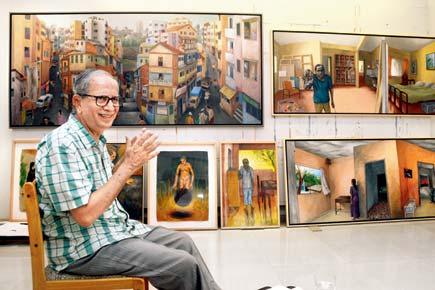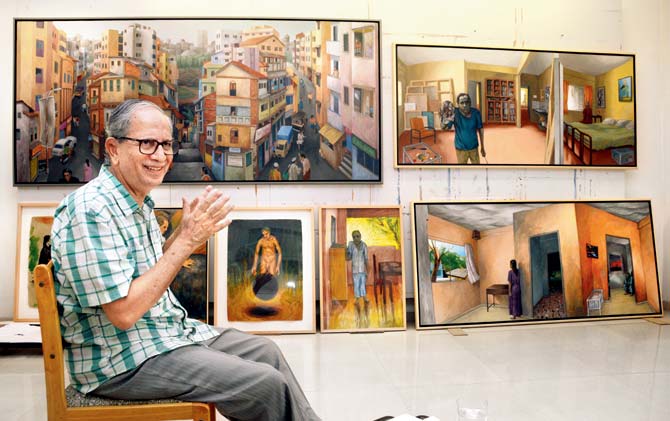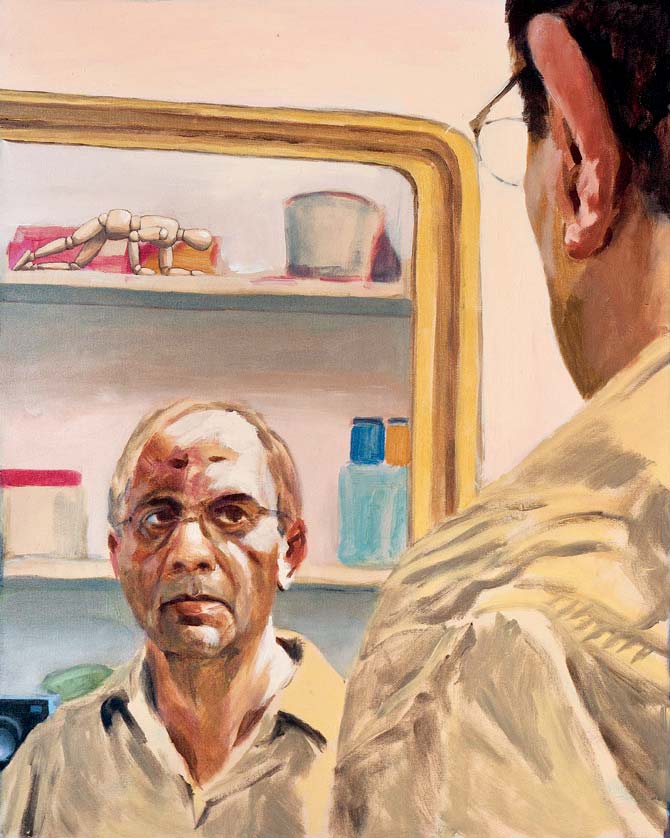The artist's latest body of work turns him away from cityscapes to the privacy of his home


Artist Sudhir Patwardhan at his studio in Thane with new works for his upcoming solo exhibition, Spectres. PICs/SATEJâÂÂu00c2u0080ÂÂu00c2u0088SHINDE
ADVERTISEMENT
At his Thane residence, Sudhir Patwardhan leads us through a brief passage to a room that doubles up as a studio. The walls have been taken over by paintings for the artist's upcoming solo exhibition, Spectres.
Patwardhan's first-floor apartment -- its windows, its rooms, its occupants -- has unravelled itself on these canvases, making the paintings seem like distortion mirrors that reflect the very space they are housed in. Call it a viewing room or a funhouse, but standing there in the studio, the illusion is complete. It is compelling. You feel like you have walked straight into the paintings and not just the house.
Patwardhan, 68, is recognised as one of Mumbai's most prominent contemporary artists who became synonymous with the metropolis' changing urbanscape. A practising radiologist until about eight years ago, he recreated Mumbai's teeming streets in several works, commenting on urban growth and class stratification, and catching the pulse of the city.

The year 2011 marked an obvious shift in Patwardhan's artistic career, with his exhibition, Family Fiction, presented by Sakshi Gallery. In an essay, titled Home as Studio, which he wrote for the exhibition, Patwardhan explains his shift from large cityscapes and a long preoccupation with the idea of community. "The current body of work is a turning away from these overtly social concerns. The space of the family has acquired greater importance in my work in the past two years. Many of the works in this show are interiors and images of people at home. They are family narratives," he had written. The thought is explored more deeply in Spectres, which opens on October 3 at Jehangir Art Gallery, Kala Ghoda. This exhibition of 80 new works is presented by Vadehra Art Gallery and intended as a week-long preview before the exhibition opens in New Delhi later this month.
A pendulum
In Spectres, Patwardhan explores the most intimate relationships, between man and woman, and the self. Since he retired, Patwardhan spends more time at home. "I used to meet more new people at the clinic. It used to feed into my work. I travel lesser than I used to and naturally meet fewer people now. Ageing is certainly a theme," he says, adding that he finds more time to attend the openings of his friends' art exhibition since he retired. "There are other psychological areas, such as the existence of both love and tension in a home. There is a longing to tear apart and break free as much as be with the family," he continues.
The protagonists in Spectres almost always occupy their own rooms or corners. It would seem that man and woman are caught in a maze. Are they seeking each other out or just themselves?
His wife, Shanta, briefly converses with us as she offers us cut fruits and hot chai. When we ask her what she has to say about her husband's latest oeuvre, she smiles, "Earlier, he used to paint what he sees, now he paints what he thinks."
Her brief observation puts Spectres into perspective. In Erase, an old hunched figure looks resignedly but directly at the viewer. He holds a cloth in his hand, and seems like he is wiping the painting he inhabits.
The thought extends to his self-portraits through the use of reflections and cameras. "A self-portrait has always been the ultimate statement that an artist can make. Thanks to the virtual world, we are used to the idea of multiple selves today. However, I would rather refer to Rembrandt's self-portrait," he says, pointing to a small print of the painting hanging by the window. "Rembrandt created these by looking into a mirror. I suppose that the true self exists somewhere between these multiple layers. As an artist, I am trying to go beyond these representations and get to the truth. But, there is a difficulty doing so," he says.
Patwardhan has been often boxed and restricted by a myopic reading of his cityscapes. Amidst the obvious inwardness of these new works, which Patwardhan has been making for the last three years, there is only one cityscape, this time a slice of Pune rather than Mumbai. The grey corporate city looms in the distance like an foreboding sandstorm, while the old, colourful city is in the foreground. This is a city of Patwardhan's childhood; it is also a retreat from Mumbai. "I think Mumbai has changed a lot. It no longer feels like the city I once belonged to. I bite into the city from time to time, when it does call out to me, but I am finding new ways of confronting it."
 Subscribe today by clicking the link and stay updated with the latest news!" Click here!
Subscribe today by clicking the link and stay updated with the latest news!" Click here!







